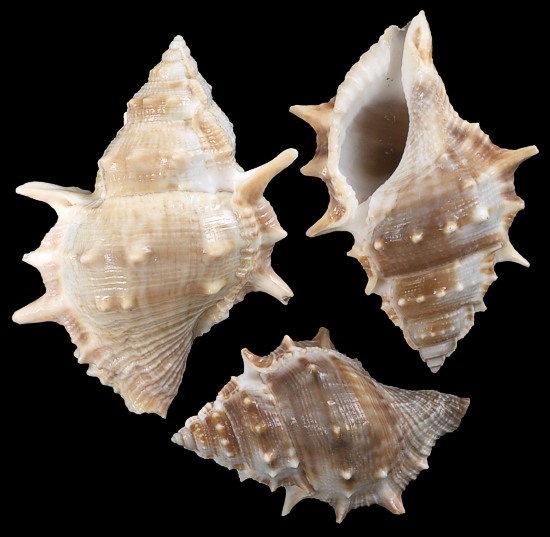As the site is updated, each listing includes the shipping cost. Some listings which I have not updated still give you calculated shipping costs based on weight and size of package. (In the sections I have updated) If you select several different listings, we will consolidate your order and charge you the actual cost of the entire package. The shipping over charge will be refunded to you, when your order is shipped.
FROG SHELLS OF THE TROPICS

Bursidae common name frog snails or frog shells
Bursidae are of a small taxonomic family of large sea snails, marine gastropod predatory snails in the clade Littorinimorpha.A majority of species in this family live on rocks or coral reefs in shallow waters of tropical oceans, including the Indo-Pacific, the Caribbean Sea, and other warm seas, but they are also found in the Atlantic Ocean and the Mediterranean Sea. They are rarely seen on sandy bottoms of deeper waters of the continental shelf.
(REF: Mollusca Base eds. (2020). MolluscaBase. Bursidae Thiele, 1925)
These species have a slightly elongated shell, are coarsely sculptured, resembling the triton shells of the Ranellidae. The intersection of the spiral ribs and the axial sculpture results in a strong nodulose pattern of more or less round knobs. This warty surface gave them their common name - frog shells. The outer varicose lip is dilated and shows a number of labial plicae, resulting in a toothed lip on the inside. The inner lip is calloused, showing transverse plicae.
The anterior and posterior canals are well developed. The siphonal canal at the anterior end is usually short.(The siphonal canal is an anatomical feature of the shells of certain groups of sea snails within the clade Neogastropoda. Some sea marine gastropods have a soft tubular anterior extension of the mantle called a siphon through which water is drawn into the mantle cavity and over the gill and which serves as a chemoreceptor to locate food. Siphonal canals allow for active transport of water to sensory organs inside the shell. Organisms without siphonal canals in their shells rely on passive or diffuse transport or water into their shell. Those with siphonal canals have a direct inhalant stream of water that interacts with sensory organs to detect concentration and direction of a stimulus, such as food or mates. In certain groups of carnivorous snails, where the siphon is particularly long, the structure of the shell has been modified in order to house and protect the soft structure of the siphon. Thus the siphonal canal is a semi-tubular extension of the aperture of the shell (The aperture is an opening in certain kinds of mollusk shells: it is the main opening of the shell, where the head-foot part of the body of the animal emerges for locomotion, feeding) through which the siphon is extended when the animal is active.) The anal canal at the posterior end is a deep slot. The strong axial varices are often in two continuous series per whorl, one down each side of the shell. The nucleus of the corneous operculum is situated either at the anterior end or the mid-inner margin. A periostracum (hairy covering of the outer shell) is usually absent or thin.
The taenioglossate radula has seven teeth in each row: one central tooth, flanked on each side by one lateral and two marginal teeth. The central tooth is saddle-shaped, with long basal limbs, each bearing a cusp-like spur upon its face.
Their eyes are based at the base of their filiform tentacles. The foot is short and thick.
Fertilization is internal. The female snail lays her eggs enclosed in a jelly-like matrix that she sometimes broods with her foot. After hatching, the eggs become free-swimming larvae.
Frog shells are active predators, and appear to feed on bristle worms (Polychaeta) that they anaesthetize with acidic saliva through their extensible, distally flattened probosces.
A proboscis is an elongated appendage from the head of an animal, either a vertebrate or an invertebrate. In invertebrates, the term usually refers to tubular mouthparts used for feeding and sucking. In vertebrates, a proboscis is an elongated nose or snout.
(REF: "Bursidae". Integrated Taxonomic Information System.) (REF: Cossignani, Tiziano (1994). Bursidae of the World. Ancona, Italy)(REF: Dekkers, Aart M (2021). "About abnormalities on the number of eyes and the evolution of the possible eye-sight related shell aspects in Strombidae; introducing new shell terms in Strombidae morphology (Gastropoda: Stromboidea, Strombidae)
Scientific classification
Domain: Eukaryota
Kingdom: Animalia
Phylum: Mollusca
Class: Gastropoda
Subclass: Caenogastropoda
Order: Littorinimorpha
Super family: Tonnoidea
Family: Bursidae
A1-7
Three Frog Shells, measuring 2 to 2.5 inches. ..... $5.95
xA1-7
Twelve Frog Shells, measuring 2 to 2.5 inches. ..... $8.95
xxA1-7
Twenty five Frog Shells, measuring 2 to 2.5 inches. ..... $15.95
xxxA1-7
Fifty Frog Shells, measuring 2 to 2.5 inches. ..... $25.95
xxxxA1-7
One hundred Frog Shells, measuring 2 to 2.5 inches. ..... $38.95